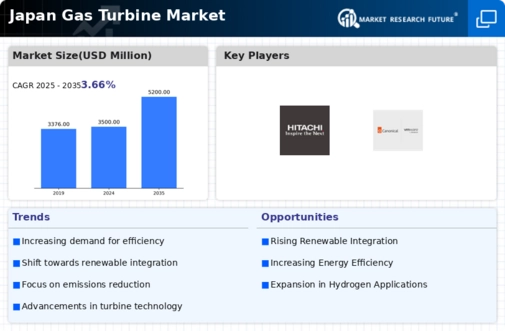Rising Energy Demand
The gas turbine market in Japan is experiencing a notable surge in demand due to the increasing energy requirements of its industrial and residential sectors. As the population grows and urbanization accelerates, the need for reliable and efficient energy sources becomes paramount. In 2025, Japan's energy consumption is projected to rise by approximately 2.5%, necessitating the expansion of power generation capacities. Gas turbines, known for their efficiency and lower emissions compared to coal, are becoming a preferred choice for new power plants. This trend indicates a robust growth trajectory for the gas turbine market, as utilities and independent power producers invest in modernizing their fleets to meet the rising demand while adhering to stringent environmental regulations.
Environmental Regulations
Japan's stringent environmental regulations are significantly influencing the gas turbine market. The government has implemented policies aimed at reducing greenhouse gas emissions, which has led to a shift towards cleaner energy sources. Gas turbines, which emit lower levels of CO2 compared to traditional fossil fuel sources, are increasingly favored. In 2025, it is estimated that the share of gas-fired power generation in Japan will reach 40%, reflecting a growing commitment to sustainability. This regulatory landscape encourages investments in advanced gas turbine technologies, further driving market growth. The gas turbine market is thus positioned to benefit from these environmental initiatives, as companies seek to comply with regulations while maintaining operational efficiency.
Technological Innovations
Technological innovations are playing a crucial role in shaping the gas turbine market in Japan. Advances in turbine design, materials, and control systems are enhancing the performance and efficiency of gas turbines. In 2025, the introduction of next-generation gas turbines is expected to improve thermal efficiency by up to 10%, making them more competitive against other energy sources. These innovations not only reduce fuel consumption but also lower emissions, aligning with Japan's environmental goals. As manufacturers invest in research and development, the gas turbine market is likely to witness a wave of new products that cater to the evolving needs of the energy sector, thereby driving growth and competitiveness.
Investment in Infrastructure
The gas turbine market in Japan is poised for growth due to substantial investments in energy infrastructure. The government and private sector are channeling funds into upgrading existing power plants and constructing new facilities. In 2025, it is anticipated that investments in gas turbine technology will exceed $10 billion, driven by the need for enhanced energy security and reliability. This influx of capital is likely to facilitate the adoption of cutting-edge gas turbine systems, which offer improved efficiency and lower operational costs. As infrastructure projects progress, the gas turbine market is expected to expand, providing opportunities for manufacturers and service providers to capitalize on the evolving energy landscape.
Shift Towards Decentralized Energy Systems
The gas turbine market in Japan is experiencing a shift towards decentralized energy systems, driven by the need for energy resilience and reliability. As natural disasters pose risks to centralized power generation, there is a growing preference for distributed generation solutions. Gas turbines, with their ability to be deployed in smaller, modular configurations, are well-suited for this trend. In 2025, it is projected that the market for distributed gas turbine systems will grow by 15%, as businesses and communities seek to enhance their energy independence. This shift not only supports local energy needs but also contributes to the overall stability of the national grid, further bolstering the gas turbine market.

















Leave a Comment